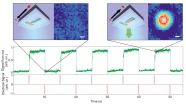INFORMATION:
Related content:
Global Food Security 2030- Assessing Trends in View of Guiding Future EU Policies:
https://ec.europa.eu/jrc/en/publication/eur-scientific-and-technical-research-reports/global-food-security-2030-assessing-trends-view-guiding-future-eu-policies
Foresight food security: From hunger and poverty to food system approach
2015-08-18
(Press-News.org) Long considered in relation to malnutrition and humanitarian aid, food security policy should be moving towards a much broader landscape and focusing on regular access to food for a population nearing nine billion towards 2030-2050, while addressing food insecurity for a fraction of communities, according to a JRC foresight report.
Due to a growing population, climate change, limiting expansion of agricultural land and increasing demand of high-energy food input, achieving global food security will be one of the most critical challenges in the coming years. Traditionally the debate on food security has focused on production and agricultural aspects, as well as hunger, poverty and humanitarian aspects. Instead with this foresight study, the JRC proposes to go further and move towards a more comprehensive and systemic approach to explore this complex issue.
By 2030 and beyond, food security will increasingly be considered as securing food supply in response to changing and growing global demand. Food security is not only a global and systemic challenge, but also an opportunity for the EU to play a role in innovation, trade, health, wealth generation and geopolitics. Better coordination and coherence at EU level are necessary in order to move from a food-security to a food-systems approach.
The JRC foresight on global food security brought together the European Commission, external experts and stakeholders to develop a vision for food security in 2030. The approach foresees a significant reduction in the relative number of undernourished people. Food security will be guaranteed on a sustainable base through four processes: extensive transformation of agriculture production systems through investment, research and training; adequate rural transformation; balancing of production and consumption in the food systems between local, regional and global levels, and finally, moving towards a demand-driven food system, with responsible consumer behaviour shaping sustainable objectives.
ELSE PRESS RELEASES FROM THIS DATE:
Linking molecules to microbes
2015-08-18
This news release is available in German.
Microbes are the oldest and most successful organisms on the planet, and they communicate and interact using chemistry as their language. While research of the past decades has uncovered fascinating insights into the chemical interactions of microorganisms in the laboratory, it remains extremely challenging to understand what happens in the natural environment. One of the key issues is the difficulty to tie the production of particular molecules to individual bacterial cells or at least populations of cells in complex environmental ...
High-precision control of nanoparticles for digital applications
2015-08-18
For the first time ever, researchers have succeeded in creating arrangements of colloids - tiny particles suspended in a solution - and, importantly, they have managed to control their motion with high precision and speed. Thanks to this new technique developed by scientists at the University of Zurich, colloidal nanoparticles may play a role in digital technologies of the future. Nanoparticles can be rapidly displaced, require little energy and their small footprint offers large storage capacity - all these attributes make them well suited to new data storage applications ...
Johns Hopkins researchers sound off on the dangers of hospital consolidation
2015-08-18
In a commentary published in the Aug. 13 issue of JAMA, Johns Hopkins experts say consolidation of hospitals into massive chains threatens healthy competition, reduces patient choice and could drive up medical expenses.
The authors call on the Federal Trade Commission -- the regulatory body overseeing business practices and consumer protection -- to be more vigilant and cautious when hospital systems seek approval to consolidate and to pay particular attention to geographic regions where proposed mergers could create a single dominant hospital system.
"It's really Economics ...
Mothers give more than they receive when family struck by major illness
2015-08-18
AMES, Iowa - Mothers are often the caregiver when a child is sick, and that motherly instinct doesn't go away when the child is an adult. In fact, mothers provide more support to adult children with a serious health condition than to their other children, according to new research that will be presented at the American Sociological Association 2015 Annual Meeting.
It's a situation that can put older mothers in a vulnerable position, said Megan Gilligan, lead author and assistant professor of human development and family studies at Iowa State University. Gilligan and ...
Proof-of-concept study shows potential for ultrasound to detect signs of preterm labor
2015-08-18
Researchers from North Carolina State University, Institut Langevin and Paris-Descartes University have conducted a proof-of-concept study that raises the possibility of using ultrasound techniques to detect cervical stiffness changes that indicate an increased risk of preterm labor in pregnant women. While additional work needs to be done, it may ultimately give doctors a new tool for determining when to provide treatment that can prevent preterm birth.
Premature births can mean low birthweights and other medical problems for newborns, but there are steps that doctors ...
Examining the fate of Fukushima contaminants
2015-08-18
An international research team reports results of a three-year study of sediment samples collected offshore from the Fukushima Daiichi Nuclear Power Plant in a new paper published August 18, 2015, in the American Chemical Society's journal, Environmental Science and Technology.
The research aids in understanding what happens to Fukushima contaminants after they are buried on the seafloor off coastal Japan.
Led by Ken Buesseler, a senior scientist and marine chemist at the Woods Hole Oceanographic Institution (WHOI), the team found that a small fraction of contaminated ...
Just 1 in 10 are referred for cardiac rehab after treatment for heart failure
2015-08-18
Only 1 in 10 heart failure patients is referred to a cardiac rehabilitation program after being hospitalized, despite strong evidence that such exercise programs improve quality of life and reduce the likelihood of future hospitalizations.
The findings, from a UCLA-led study, appear in the August 25 Journal of the American College of Cardiology. Researchers drew the data from a national database of more than 100,000 people with heart failure who were discharged from hospitals between 2005 and 2014 and were eligible for cardiac rehabilitation programs.
"Although we expected ...
Breakthrough optics pave way for new class of intriguing technologies
2015-08-18
A new class of fascinating technologies -- including optics in computing, telecommunications links and switches, and virtually any other optical component -- could be created simply by configuring a mesh of light-controlling devices known as interferometers. This is similar to the way electronic semiconductors can fashion the wide array of digital technologies we have at our disposal today.
Optical technologies have the potential to greatly reduce the power consumption of computers, speed telecommunications, and enhance the sensitivity of chemical and biological sensors. ...
Pediatric training essential to improving out-of-hospital emergency care for children
2015-08-18
A national survey of more than 750 emergency medical services providers conducted by researchers at Oregon Health & Science University identified airway management skills, personal anxiety and limited pediatric care proficiency among key factors that may contribute to pediatric safety events for children in out-of-hospital emergent care situations. The study, published online today in The Journal of Pediatrics, supports the American Academy of Pediatrics' recommendation for pediatric physician involvement in EMS training, medical oversight and policy development.
"Pediatric ...
Massacres, torture and mutilation: Extreme violence in neolithic conflicts
2015-08-18
Violent conflicts in Neolithic Europe were held more brutally than has been known so far. This emerges from a recent anthropological analysis of the roughly 7000-year-old mass grave of Schöneck-Kilianstädten by researcher of the Universities of Basel and Mainz. The findings, published in the journal PNAS, show that victims were murdered and deliberately mutilated.
It was during the time when Europeans first began to farm. To what degree conflicts and wars featured in the early Neolithic (5600 to 4900 B.C.), and especially in the so-called Linear Pottery culture ...




